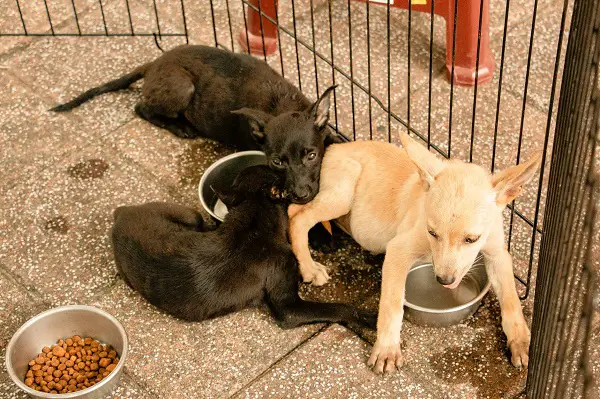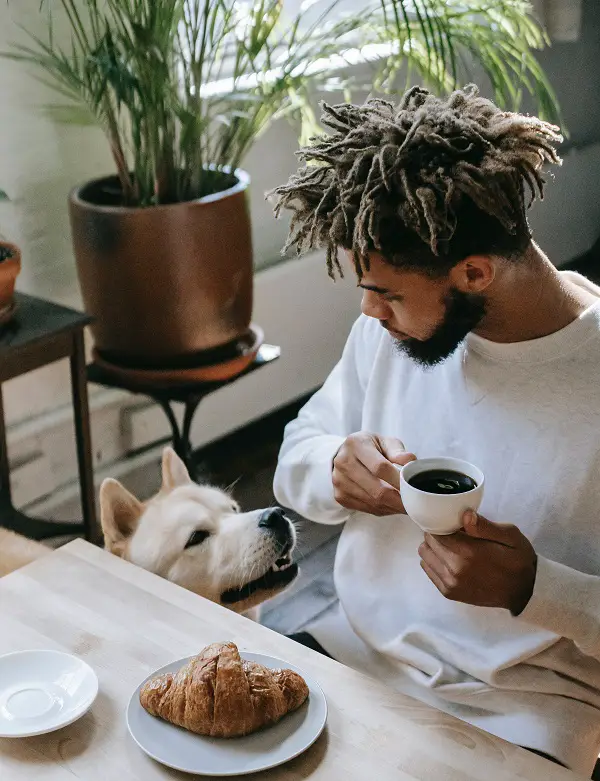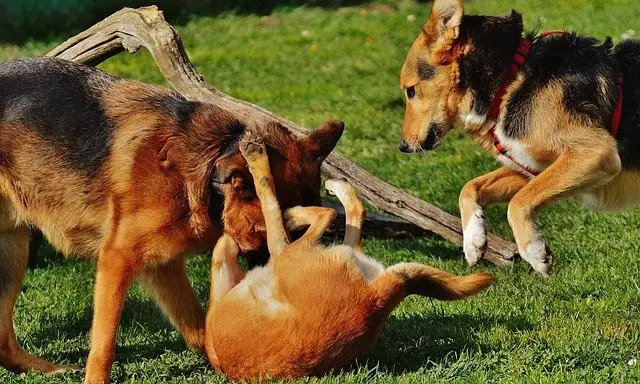Because we are pack animals, dogs can and will often thrive in a household where there is more than one canine.
Even though we are long separated from our day as wild animals, we still hold on to some of our natural instincts, one of which is being territorial. In many households with more than one dog, these territorial tendencies may never show themselves. In others, though, it can be quite prevalent.
One of the biggest things we feel the need to guard against other dogs is our food. In the wild, food is a valuable resource, and protecting it would mean the difference between eating and not eating on any given day.
So, if your pup is starting to show some aggression toward the other dogs in the house when it comes to mealtime it is completely normal. That doesn’t mean, though, that we should be left to our own devices when it comes to eating, as that normal aggression can quickly get out of hand and lead to fighting and some very unpleasant situations. If your dogs are starting to fight over food, it’s important to do something about it before it gets out of hand and becomes hard to control.
Understanding Food Aggression
Simply put, food aggression is any hostile action that a dog takes to guard what they feel is rightfully theirs. This aggression can be anything from a slight growl anytime another dog comes near to full-on lunging and attacking. Whatever the case, the other dog will more than likely feel the need to defend themselves. While it may not amount to anything, it could lead to a very bad situation.
Food aggression is considered by dog experts to be resource guarding and is a behavior that has been passed on through our evolution from wild pack animals to household family members. The behavior itself isn’t necessarily something to be concerned about. It’s a perfectly natural instinct for any dog. Just because your pup is exhibiting this type of behavior doesn’t mean that there is something wrong with them. What could be concerning is how severe the behavior is.
Not only is it important to control food aggression and dogs fighting over food for the safety of pets in your home, but it is also important for the safety of children and adults. If left unmanaged, dogs will not distinguish the difference between specific threats and will treat anyone or anything with the same level of aggression, leading to dangerous situations for anyone who dares to enter the area your dog wants to protect.
Understanding the Causes of Food Aggression

While resource guarding is an instinct, and one of the most common reasons your dogs may be fighting over food, there can be other causes.
- It Can Be Learned – It is entirely possible that the aggression that has led to your dogs fighting over food was learned at a young age. As puppies are weaned from their mothers, breeders will more than likely have a common area where young pups are fed their kibble. Competing with their siblings over a bowl or trough of food can quickly teach a pup to always be on guard while eating.
Similarly, adult dogs that spend any amount of time in a shelter are very quick to learn that resources can be limited, and the need to protect those resources becomes an important part of everyday life. Not only do they feel the need to protect what they have, but fighting over food with other dogs can become commonplace.
- Genetics – Some breeds are more likely to have guarding tendencies in their blood than others. Dogs like German Shepherds, Rottweilers, and Pit Bulls are known to be more aggressive than other breeds and their hereditary guarding instincts in combination with this aggressiveness can lead to a dog that is more likely to fight over their food than others.
- Medical Issues – This can be a tough one to narrow down, but it is important to understand that if your dog is displaying aggressive behavior when eating that is out of the norm for them, you should take them to the vet for a checkup to help rule out any type of medical condition.
Any medical issue that is causing your pup pain could easily be a trigger of aggression. Dogs that are in pain can be more inclined to be defensive or feel more threatened when approached.
Deteriorating eyesight or hearing are other good examples of medical conditions that can be causing your dog to become more aggressive when eating. Because they are less aware of their surroundings, they will naturally become more defensive. If caught off guard, they could be more likely to want to fight for what they have.
- Trauma – Trauma can turn even the most passive dog into an aggressive one. While that aggression may not show its ugly head in most routine, everyday activities, mealtimes can become a problem.
Trauma can range from losing a loved one to abuse and neglect to experiencing a natural disaster. It may not always be easy to pinpoint what kind of trauma your dog may have experienced, but it may be helpful to try and determine the root cause and eliminate possible exposure. Trauma results in anxiety, and anxiety can lead to overprotectiveness.
Understanding the Signs of Food Aggression

To effectively prevent your dogs from fighting over food, it’s important to understand the signs of food aggression. While there are many different signs, and varying degrees of severity of these signs, they can be typically broken down into three categories.
- Mild – Mild signs of food aggression are typically verbal. When your dog is eating and is approached by another dog or even a person, they will growl. The growl can also be coupled with your dog showing their teeth or their hair standing up.
Mild signs of food aggression may never progress past that and might not lead to any fighting at all depending on the mannerism of the other dog. Growling and showing their teeth is a way for a dog to tell others that they do not want them near and if the second dog understands this they will generally back away.
That doesn’t mean, though, that mild signs of aggression won’t progress into something more serious.
- Moderate – Moderate signs of food aggression take the growling one step further and are often the first step in your dogs fighting over food. Instead of simply growling as a warning, a dog will combine that growling with snapping and lunging. It might stop there, but it’s more than likely another dog is going to react defensively and the fight will be on.
- Severe – Severe signs of food aggression are easy to spot and nothing to take lightly. It starts with growling, snapping, and lunging, and ends with chasing and biting. This stage is not only dangerous for other pets but people as well.
The kind of aggressiveness that is exhibited here will most certainly end up in a fight between your dogs and will likely be something incredibly hard to get under control and extremely dangerous for any party involved.
How To Prevent Dogs Fighting Over Food

Just because your dog may be displaying some or all of these aggressive behaviors, it doesn’t mean they are becoming a lost cause. Anytime your dogs fight, it can be a scary situation, but that doesn’t mean it isn’t manageable and even preventable. Here are six ways to do just that.
- Separate Eating Areas – The best way to prevent your dogs from fighting over their food is by separating them at mealtimes. Dogs that feel threatened or feel the need to defend their food will not do so if there are no immediate threats while eating.
Separating them does not mean two different areas in the same room, but instead, they should be fed in two separate rooms, closed off from being able to see each other while eating. Not being able to see each other will put each dog more at ease and will make mealtime more enjoyable.
If your dogs are fighting while eating together, then separate eating areas may need to be a permanent thing, but it doesn’t always have to be. There are situations where separating them for a short time – maybe a few days – can reassure them that they aren’t actually a threat to each other. Once they have that reassurance, it may be possible to slowly introduce mealtimes in the same room and eliminate fighting altogether. If you intend to have them start eating in the same room again, it should be done gradually and with caution.
- Separate Bowls – It should go without saying that dogs who share a bowl are more likely to fight over what they have. Dogs don’t share well, and being forced to do so could lead to a less than desirable situation.
Separating their feeding bowls goes hand in hand with separating the feeding areas and could be considered the same in many situations, with the idea that out of sight, out of mind plays a major role in keeping your dogs from fighting.
- Desensitize Your Dogs – Now that you have the dogs eating separately, it’s easier to desensitize them from the presence of others, whether it’s you, your kids, or other dogs.
Give your dog their bowl of food and stand by them while they eat it. Depending on just how aggressive they are, this may not be something they are too happy about at first. However, over time, they will start getting used to it.
Calmly talking to them while you stand near their bowl is a good way to put them at ease while they are eating. Asking them simple questions about their food will help calm them and understand that you are not there to take their food. This will then translate into them being less anxious when other dogs are around.
- Feed Them By Hand – I’m not suggesting that you feed your dogs their entire meals by hand. However, giving them a few kibbles before they dive into the meal can go a long way toward letting them know that you are the one that is in charge and that you will make sure that there is enough food to go around.
This doesn’t necessarily have to be done with their food itself, but it can also be done with a pre-meal treat. As you hand feed them their treat or kibble, speak to them in a calming tone, reassuring them that everything is OK. Once they have taken the offering, set their bowl down and walk away. By leaving, you are assuring them that you have no interest in taking their food.
- Use a Consistent Schedule – Just like our humans, dogs thrive on routine. Knowing when to expect their next meal means that they are less likely to stress about it and in turn are less likely to feel the need to have to guard it.
Different dogs sometimes require different feeding schedules, but having both dogs on the same schedule will enforce routine for both. They will come to realize that the food is plentiful and that there is enough for both of them.
Spreading out their mealtimes can also have a similar effect as it proves to them that they will always receive consistent feeding.
- Feed Your Dogs After You Have Eaten – All of the dogs in the household need to understand that they are part of a pack, and not the leader of that pack. You are the leader, and eating your meals before your dogs do will enforce this fact. While it may seem a little out there, by seeing you eating first, your dogs will quickly realize that they are not competing to be the alpha in the household, but rather relying on you to provide for them. This will reduce and even eliminate fighting as they will no longer feel the need to assert themselves.